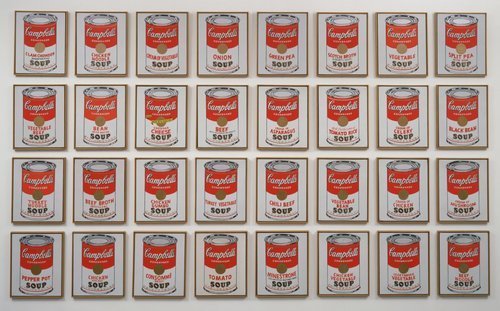
Unique Reproduction

T. Kinkade: "Snow White Discovers the Cottage" 2008 (http://www.artofthesouth.com/Thomas_Kinkade/snowwhitediscoversthecottage.php)

A. Warhol: "Campbell's Soup Cans" 1962 (http://www.moma.org/collection/object.php?object_id=79809)
Like politics, controversy cannot be separated from art. Debate is part of
the life blood of art, it adds much interest, and interest most often brings
in fame and money. However, just because money is invested into a piece does
not mean it is valuable artwork. For example, many, if not most, would consider
Thomas Kinkade’s work to be inferior to the work of Warhol. What is
it that contrasts these works from each other? The context, paintings, and
the artists themselves often have quite a bit to do with it. The collection, “Campbell’s
Soup Cans” by Warhol and “Snow White Discovers the Cottage” by
Thomas Kinkade are two simply-named pieces that have differences in form,
context, and content that can exemplify differences in the aesthetics of
the pieces, but also between broad categories of art as well.
Before one can understand the individual pieces and their incongruences,
it is important to compare artists themselves. Warhol and Kinkade may seem
like
two drastically different men, but in reality they had significant similarities.
Both icons are American artists of a similar time period, Warhol beginning
his glory days in the sixties and ending with his death in 1987, and Kinkade
still producing thousands of works to date, producing being a vague term since
he never touches most of the artwork with his name on it. This style of mass
production art was also utilized by Warhol, but not to the same extreme. Warhol
often described his studio as “The Factory”1, and wanted to be
so prolific that he himself was viewed as a machine. A key difference is that
while both artists were interested in commercializing their work, Warhol was
still the designer and creator of all of his work.
The “Campbell’s Soup Cans” collection and “Snow White
Discovers the Cottage” have extraordinary differences in form. Warhol’s
piece was created by silk-screening, a process that involves stenciling and
transferring ink or paint. To some, this may appear like cheating, but Warhol
not only had to create the screen prints himself, but he popularized it into
a style of art that had not been a big part of culture in the past. The material
used to create the original “Snow White Discovers the Cottage” was
oil paints, but all other copies are simply reproductions by computer, with
an apprentice who paints highlights onto the painting. This appears to have
little affect on the aesthetics of the pieces, except upon close inspection,
which may be why the experts generally prefer the former and the common population
the latter.
Contextual issues play a large part in how artwork should be viewed. Although
diverse in materials, at first the pieces by Warhol and Kinkade seem similar
in theme and content, but upon closer inspection, have completely independent
meanings. Kinkade has said about his art “What I paint touches on foundational
life values. Home, family, peacefulness. And one of the messages I try to constantly
get across is slow it down and enjoy every moment.”2 This is evident
in “Snow White Discovers the Cottage”. Kinkade is bringing a part
of American culture that everyone is familiar with into art. The same could
be said about “Campbell’s Soup Cans”. However, the main difference
is that Kinkade fails to introduce any of his own idea into the piece. Rather
than a piece of art that gives a new perspective, the painting just reemphasizes
what most already know about the American culture. On the other hand, Warhol’s
piece (which he never comments on), reflects culture in the same manner, but
in a way that requires the reader to think about what it means, and how it
ties us all together. Warhol’s way of repeating the soup cans can be
interpreted to show connections between all classes of American people, or
critical of our style of consumerism. Either way, there are many interpretations
of the soup cans, while the painting of Disney’s Snow White inspires
little thought.
On the surface side of the matter, the aesthetical details of the works matters.
There appears to be a tradeoff in creativity and skill between the two pieces.
It can be said with a good amount of certainty that “Campbell’s
Soup Cans” could be replicated by most artists and frauds, but the genius
behind the piece was that Warhol was the first to think of making a masterpiece
out of such a simple, mundane object. Kinkade has the opposite effect. His
piece (the original, at least), does not have much of his own ideas, yet the
aesthetics of it make it appear to have required much skill to paint. Although
the painting would be fairly easy to duplicate, proven by Kinkade himself,
its complexity makes it seem to be more difficult to copy. However, more detail
isn’t always better. A final point is that it is clear that many find
Kinkade’s works such as “Snow White Discovers the Cottage”,
to be very aesthetically appealing, maybe even more so than “Campbell’s
Soup Cans”. The colors and the familiar scenes are comforting to most
Americans, and this, combined with the more affordable pricetag, are reasons
why more Americans own Kinkades than art from any other artist. Just like other
parallels, beauty is only skindeep, and why the more experienced art world
members do not appreciate Kinkade.
Understanding art is more challenging than most think. The mere aesthetics
of the piece are usually not enough, and have to be considered with contextual
issues and awareness of how the artwork was created to gain a true comprehension
of what an art piece is worth. Nowhere is this more evident in the works
of pop artists such as Warhol, and business artists such as Kinkade.
Works Cited
1. "Pop Artist and Cultural Icon." The Andy Warhol Foundation. The Andy Warhol Foundation for the Visual Arts, 2011. Web. 2 Nov. 2011.
2."Thomas Kinkade Quotes." ArtQuotes.net. N.p., n.d. Web. 2 Nov. 2011.
Additional Sources
Kinkade, Thomas. Snow White Discovers the Cottage. 2008. Oil on canvas. Private Collection.
Warhol, Andy. Campbell's Soup Cans. 1962. Screen print. Museum of Modern Art, New York.
____________________________________________________
By: Rachel Bender
Major: Psychology
Expected Graduation Date: May 2015
Hometown: Woodland, WA
I chose to compare works from Kinkade and Warhol based on the common ground
of the images they created for themselves. Both men achieved reputations of
being businessmen in the art world; for this paper I wanted to examine the
differences in the art itself that allows for Warhol to be recognized and held
in high esteem in the art world, and why Kinkade is not.